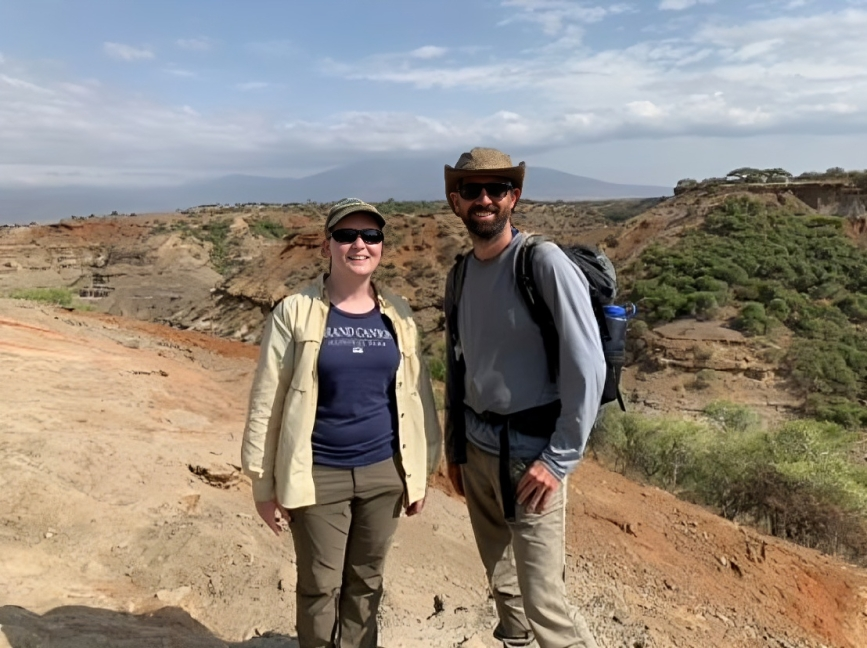
Dr. Karen Alley (left) posing with Dr. Paul Durkin (right) in front of Olduvai Gorge.
Exploring Tanzania: UM professors gather at Olduvai Gorge
Last summer, Clayton H. Riddell Faculty of Environment, Earth, and Resources professors Dr. Karen Alley and Dr. Paul Durkin met at Olduvai Gorge in Tanzania to discuss the Stone, Tools, Diet, and Sociality at the Dawn of Humanity (SDS) project.
When most people I’ve talked to think of Tanzania, they picture the wildlife: cheetahs running down gazelles, towering giraffes browsing the trees, wildebeest being stalked by lions, and herds of lumbering elephants. The plains of the Serengeti host all this and more, but these are not the only treasures that Tanzania has to offer. A bit to the south of Serengeti National Park is the Ngorongoro Conservation Area, a UNESCO World Heritage site that protects a huge volcanic caldera packed with wildlife. And on the edge of this conservation area is a beautiful but nondescript set of dry, dusty shallow canyons known as Olduvai Gorge.
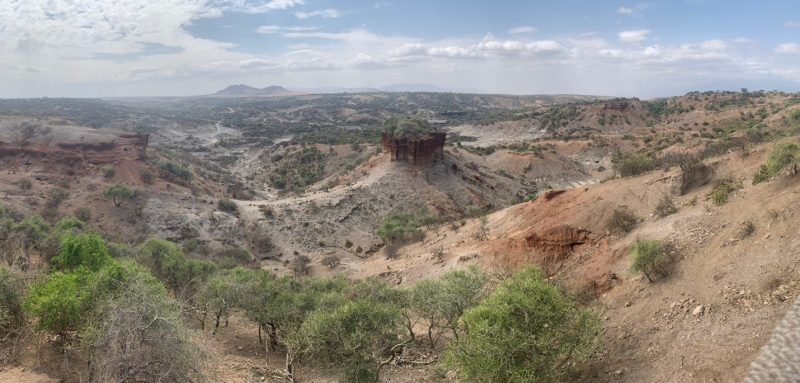
The landscape as seen from Olduvai Gorge in Tanzania.
Although it became famous as “Olduvai Gorge,” the name is a misnomer: it is correctly referred to as “Oldupai Gorge,” named for a spiky flowering plant that grows commonly in the region. In the early 1900s, German geologist Hans Reck discovered the fossils of 17,000-year-old human ancestors in Oldupai Gorge. Teams led by famous archeologists Louis and Mary Leakey spent decades working here, uncovering stone tools and hominin fossils (members of our own taxonomic tribe) dating back about two million years.
Oldupai Gorge continues to yield important findings about hominin evolution. University of Manitoba Earth Sciences professor Paul Durkin contributes to this work as part of the Stone Tools, Diet, and Sociality at the Dawn of Humanity (SDS) project.
I had lunch with Paul in Fall of 2022 to chat about mutual interests; I’d started as a professor in the Department of Environment and Geography during the Covid-19 pandemic, and hadn’t yet had the chance to hear much about Paul’s work.
Paul is a sedimentologist, and he told me about the projects he’s been leading on sedimentary and river systems in Canada, using a variety of techniques including mapping with Remotely Piloted Aircraft Systems. He also mentioned his work in Tanzania, which piqued my interest. I was in the midst of planning a safari to Kenya and Tanzania with seven other members of my family – our itinerary was set, and I was eager to hear what he could tell me about the travel experience. As we chatted, we realized that my family would be passing within a couple kilometers of the SDS field site, at a time Paul was planning to be in the field. He very generously invited us to visit the field site and learn more about his work.
Visiting Oldupai Gorge
Tanzanian safaris consist mostly of dirt roads, and the route to Oldupai Gorge is no exception. We traveled south out of Serengeti and watched the landscape get drier, until we turned off the main road to drive out onto a dusty plateau. At the end of the public road, past scrubby trees and the occasional giraffe, is a recently renovated museum at the edge of a beautiful gorge. We spent a little while learning about the important fossils displayed there, including the famous 1.75 million-year-old skull of Paranthropous boisei discovered by Mary Leakey in 1959.
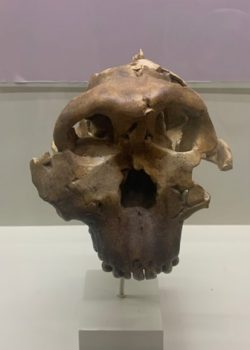
The skull of Paranthropus boisei in the Olduvai Gorge Museum.
From there, we met Paul and a couple other field-team members, who had driven up from their field site in a truck to meet us at the gate. We drove off the public roads and onto the tracks that lead into the gorge itself. Steep terrain of sometimes bare rock and sometimes sand made for challenging driving that our safari vehicles were, fortunately, well-equipped to handle. About half an hour down the road we could see a cloud of dust and a group of workers.
The Excavation Site
Members of the SDS team are systematically excavating several sites at different levels – corresponding to different sediment ages – on the edge of the gorge. The team is working to better understand the environments that early hominins experienced and how those hominins adapted to their environment using stone tools.
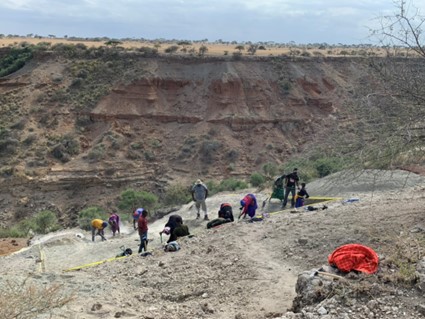
Excavations at the edge of the gorge.
Paul’s role is to analyze the sediments in which the fossils are found. Fossils are preserved at Oldupai Gorge because this is an area where sediments were collecting at the time that early hominins lived here. The layers of soft sediment and rock in the gorge include deposits from a large lake that came and went with streams on its edges, along with volcanic layers.
Paul and a team of graduate students he works with spend lots of time mapping the various geologic units in the region. Then, they take samples and detailed measurements of the various types and size of sediments, which help them reconstruct the environment where early hominins lived. In 2021, their team discovered the oldest record of Hominin occupation and documented the earliest tools they were using.
Although Oldupai Gorge has yielded many important hominin fossils and is one of the richest sites ever discovered, hominin fossils are still extremely rare. The team doesn’t expect to discover any themselves. However, their excavation sites are still filled with fossils. Paul casually pointed out several bones from an ancient Bovidae just sticking out of the edge of the cliff.
The variety of fossils helps the team learn more about the environment in ancient Oldupai Gorge. More importantly, the team has uncovered many stone tools that reveal the adaptability of ancient human relatives to their changing environment.
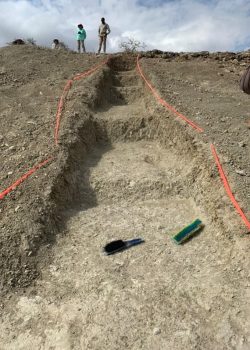
A transect that Paul and PhD student Stephen Magohe (UCalgary) excavated and analyzed, measuring sediment types and sizes in each layer.
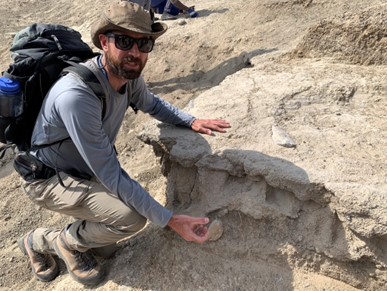
Paul pointing out a fossilized Bovidae bone in the cliff.
The SDS Camp
After spending some time telling us about the geology and the work at the excavation site, Paul took us to their camp, which we had passed on our way down the gorge.
Scientists, students, technicians, cooks, and other members of the team camp in tents during the season. Some come for a few weeks at a time, while others might be there for a few months. Along with sleeping tents, the team has a kitchen tent, and tents for storage, science, and a solar charging setup. While the landscape may seem a bit inhospitable, the team was more than welcoming, and a cold drink in the shade was very pleasant.
SDS is a multi-disciplinary and multi-national project, including partners from Canada, Tanzania, and other institutes in North America, Africa, and Europe. Their important work is shedding light on the heritage of all of humanity. It is a complex logistical endeavour that requires the dedicated efforts of many groups of people, and it was a privilege for us to get to visit and see the work in action.
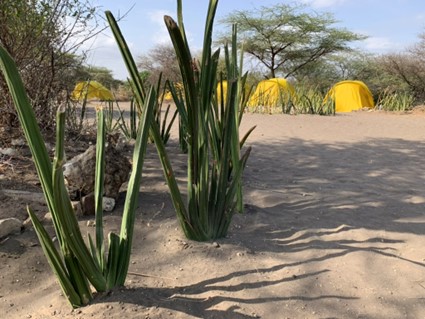
Oldupai plants in the foreground with some of the team’s tents in the background.
SDS is aiming to expand their scope and capabilities with a New Frontiers in Research Fund Transformation Grant application for funding a multi-national interdisciplinary project called ‘Dawn: Tracing the Nature of Early Human Life’.






